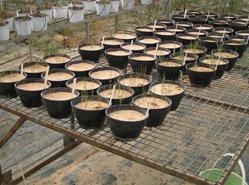Water Resource Development

Research sponsored by the IALC is aiding efforts to implement a more integrated approach to water resource management that balances development and environmental needs. IALC projects have contributed to a better understanding of the socio-economic, hydrological, and biological factors affecting water resources at the basin level and demonstrated the possibilities of water reuse and the benefits of implementing groundwater management methods to the people who use and depend on these resources.
Project Examples
-
Land Application of Wastewater for the Creation of Manmade Forests in Egypt (1999)
New Mexico State University, Ministry of Agriculture and Land Reclamation – Egypt, University of Ain Shams (Egypt)
Walter Zachritz (Principal Investigator)Applying wastewater and sludge to land for remediation has been recommended by the Environmental Protection Agency (EPA) as a method to recycle nutrients and organic matter and conserve water resources. Egypt has begun an extensive program of afforesting and reclaiming arid lands using wastewater. The objective of this research was to develop sustainable designs for Egyptian wastewater treatment systems based on land application on man-made forests. The results of this study can help to: a) predict tree growth and schedule irrigation, b) understand trees response to environmental and water stress, and c) provide better analyses of future research efforts.
-
Developing a Sustainable Groundwater Management System from Decreased Nitrogen Use (1999)
New Mexico State University
Shane Ball (Principal Investigator)Increased concern over potential contamination of groundwater from nitrogen fertilizers has generated a need for better tools to assess regulations concerning chemical use. The objectives of this project were to: a) demonstrate to farmers that by using chloride as a tracer, they can determine the irrigation and nitrogen use efficiency of their management system, b) demonstrate that this information can be used to increase profitability by decreasing nitrogen inputs, and c) develop a case study describing the factors that determine farmers' adoption or non-adoption of this natural resources innovation.
-
Arid Lands Water Resources Monitoring for Outlier Events on Un-gauged Watersheds Using Radar Rainfall Measurements (1993)
The University of Arizona, Ministry of Agriculture and Rural Development - Israel (Ruppin Institute), USDA Agricultural Research Service, Hebrew University of Jerusalem (Isreal)
Soroosh Sorooshian (Principal Investigator)Effective monitoring of water resources in arid land regions is critical for both restoration efforts and efficient land use; however frequent representative sampling requires substantial budgetary resources and is difficult in arid and semiarid areas, where rainfall events are typically more variable. An Israeli and U.S. team tested several methods of acquiring and analyzing hydro-meteorological data from isolated watersheds, including radar-rainfall estimation and comparisons with nearby experimental watersheds. The results are promising for the development of an arid lands water resources monitoring system for outlier events in un-gauged watersheds using radar-rainfall measurements, coupled with a distributed rainfall-runoff model.

